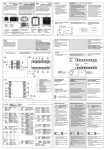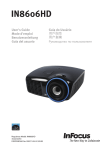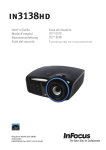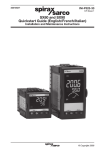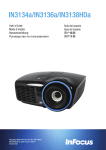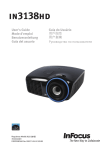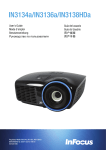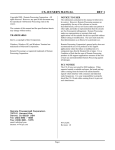Download LG Flatron L1510B 15 in. Flat Panel LCD Monitor
Transcript
Important Precautions This unit has been engineered and manufactured to ensure your personal safety, however improper use may result in potential e shock or fire hazards. In order to allow the proper operation of all safeguards incorporated in this display, observe the following basic rules for its installation, use, and servicing. On Safety Use only the power cord supplied with the unit. In case you use another power cord, make sure that it is certified by the applicable national standards if not being provided by the supplier. If the power cable is faulty in any way, please contact the manufacturer or the nearest authorized repair service provider for a replacement. The power supply cord is used as the main disconnection device. Ensure that the socket-outlet is easily accessible after installation. Operate the display only from a power source indicated in the specifications of this manual or listed on the display. If you are not sure what type of power supply you have in your home, consult with your dealer. Overloaded AC outlets and extension cords are dangerous. So are frayed power cords and broken plugs. They may result in a shock or fire hazard. Call your service technician for replacement. Do not Open the Display. There are no user serviceable components inside. There are Dangerous High Voltages inside, even when the power is OFF. Contact your dealer if the display is not operating properly. To Avoid Personal Injury : Do not place the display on a sloping shelf unless properly secured. Use only a stand recommended by the manufacturer. To Prevent Fire or Hazards: Always turn the display OFF if you leave the room for more than a short period of time. Never leave the display ON when leaving the house. Keep children from dropping or pushing objects into the display's cabinet openings. Some internal parts carry hazardous voltages. Do not add accessories that have not been designed for this display. During a lightning storm or when the display is to be left unattended for an extended period of time, unplug it from the wall outlet. A1 Important Precautions On Installation Do not allow anything to rest upon or roll over the power cord, and do not place the display where the power cord is subject to damage. Do not use this display near water such as near a bathtub, washbowl, kitchen sink, laundry tub, in a wet basement, or near a swimming pool. Displays are provided with ventilation openings in the cabinet to allow the release of heat generated during operation. If these openings are blocked, built-up heat can cause failures which may result in a fire hazard. Therefore, NEVER: Block the bottom ventilation slots by placing the display on a bed, sofa, rug, etc. Place the display in a built-in enclosure unless proper ventilation is provided. Cover the openings with cloth or other material. Place the display near or over a radiator or heat source. Do not rub or strike the Active Matrix LCD with anything hard as this may scratch, mar, or damage the Active Matrix LCD permanently. Do not press the LCD screen with your finger for a long time as this may cause some afterimages. Some dot defects may appear as Red, Green or Blue spots on the screen. However, this will have no impact or effect on the display performance. If possible, use the recommended resolution to obtain the best image quality for your LCD display. If used under any mode except the recommended resolution, some scaled or processed images may appear on the screen. However, this is characteristic of the fixed-resolution LCD panel. On Cleaning Unplug the display before cleaning the face of the display screen. Use a slightly damp (not wet) cloth. Do not use an aerosol directly on the display screen because over-spraying may cause electrical shock. On Repacking Do not throw away the carton and packing materials. They make an ideal container in which to transport the unit. When shipping the unit to another location, repack it in its original material. A2 Connecting the Display Before setting up the monitor, ensure that the power to the monitor, the computer system, and other attached devices is turned off. Positioning your display 1. Remove the tape. <Image 2> <Image 1> Put the set as the picture below <Image 1> to remove the tape. Do not remove the tape with the set up side down as the <Image 2> The base part may spring up to injure your hand. 2. Adjust the position of the panel in various ways for maximum comfort. Tilt Range : -24˚~145˚ 145˚ -24˚ Height Range : maximun 3.39inch (86.1mm) Landscape & Portrait : You can rotate the panel 90o clockwise. (* For detailed information, please refer to the Pivot Sofeware CD provided.) * Make sure not to touch the floor when the head rotates to use the Pivot function. Ergonomic It is recommended that in order to maintain an ergonomic and comfortable viewing position, the forward tilt angle of the monitor should not exceed 5 degrees. A3 Connecting the Display Using the Computer 1. Connect the signal cable. When attached, tighten the thumbscrews to secure the connection. 2. Connect the power cord into a proper power outlet that is easily accessible and close to the display. NOTE This is a simplified representation of the rear view. This rear view represents a general model; your display may differ from the view as shown. Signal Cable Power Cord Analog signal D-sub* * Varies according to model. * Wall-outlet type * PC-outlet type PC MAC Mac adapter For Apple Macintosh use, a separate plug adapter is needed to change the 15 pin high density (3 row) D-sub VGA connector on the supplied cable to a 15 pin 2 row connector. A4 Control Panel Functions Front Panel Controls Control Function Power Button Use this button to turn the display on or off. Power (DPMS) Indicator This Indicator lights up green when the display operates normally. If the display is in DPM (Energy Saving) mode, this indicator color changes to amber. MENU Button Use this button to enter or exit the On Screen Display. Buttons AUTO/SELECT Button Use these buttons to choose or adjust items in the On Screen Display. Use this button to enter a selection in the On Screen Display. A5 Control Panel Functions Control Direct Access Function 100 100 Bring up Contrast and Brightness adjustment. AUTO adjustment function PROCESSING AUTO CONFIGURATION When adjusting your display settings, always press the AUTO/SELECT button before entering the On Screen Display(OSD). This will automatically adjust your display image to the ideal settings for the current screen resolution size (display mode). The best display mode is 1024x768. CONTROLS LOCKED/UNLOCKED : MENU and CONTROLS LOCKED CONTROLS UNLOCKED This function allows you to secure the current control settings, so that they cannot be inadvertently changed. Press and hold the MENU button and button for 3 seconds: the message “CONTROLS LOCKED” appears. You can unlock the OSD controls at any time by pushing the MENU button and button for 3 seconds: the message “CONTROLS UNLOCKED” will appear. A6 On Screen Display (OSD) Control Adjustment Screen Adjustment Making adjustments to the image size, position and operating parameters of the display is quick and easy with the On Screen Display Control system. A short example is given below to familiarize you with the use of the controls. The following section is an outline of the available adjustments and selections you can make using the OSD. NOTE Allow the display to stabilize for at least 30 minutes before making image adjustments. To make adjustments in the On Screen Display, follow these steps: MENU AUTO/SELECT AUTO/SELECT MENU Press the MENU Button, then the main menu of the OSD appears. To access a control, use the or Buttons. When the icon you want becomes highlighted, press the AUTO/ SELECT Button. Use the Buttons to adjust the item to the desired level. Accept the changes by pressing the AUTO/SELECT Button. Exit the OSD by Pressing the MENU Button. A7 On Screen Display(OSD) Selection and Adjustment The following table indicates all the On Screen Display control, adjustment, and setting menus. Main menu Sub menu Reference BRIGHTNESS BRIGHTNESS CONTRAST CONTRAST COLOR PRESET To adjust the brightness and contrast of the screen 9300K To customize the color of the screen 6500K R/G/B(User Color) GAMMA POSITION V POSITION To adjust the position of the screen H POSITION TRACKING CLOCK PHASE SETUP To improve the clarity and stability of the screen LANGUAGE To customize the screen status for a user's operating environment OSD POSITION BEEP* : Adjustable NOTE The order of icons may differ depending on the model (A8~A10). * This function is available for designated models only. A8 On Screen Display(OSD) Selection and Adjustment You were introduced to the procedure of selecting and adjusting an item using the OSD system. Listed below are the icons, icon names, and icon descriptions of the all items shown on the Menu. To adjust the brightness and contrast of the screen OSD Adjust Description BRIGHTNESS / CONTRAST BRIGHTNESS To adjust the brightness of the screen. 88 100 CONTRAST To adjust the contrast of the screen. To customize the color of the screen OSD Adjust Description COLOR PRESET 9300K 6500K RED GREEN BLUE PRESET 9300K/6500K Select the screen color. • 9300K: Slightly bluish white. • 6500K: Slightly reddish white. RED GREEN BLUE GAMMA Set your own color levels. GAMMA Set your own gamma value. (-50~50) On the monitor, high gamma values display whitish images and low gamma values display high contrast images. To adjust the position of the screen OSD Adjust Description POSITION Vertical Position To move image up and down. 61 39 Horizontal Position To move image left and right. A9 On Screen Display(OSD) Selection and Adjustment To improve the clarity and stability of the screen OSD Adjust Description TRACKING CLOCK To minimize any vertical bars or stripes visible on the screen background.The horizontal screen size will also change. PHASE To adjust the focus of the display. This item allows you to remove any horizontal noise and clear or sharpen the image of characters. CLOCK PHASE To customize the screen status for a user's operating environment OSD Adjust Description SETUP LANGUAGE OSD POSITION BEEP ENGLISH ON ELAPSED TIME 1024x768/60Hz PRESET MODE 0H LANGUAGE To choose the language in which the control names are displayed. OSD POSITION To adjust position of the OSD window on the screen. BEEP* To select beep ON or OFF. ELAPSED TIME To display the use time of display. NOTE * This function is available for designated models only. A10 Troubleshooting Check the following before calling for service. No image appears Is the power cord of the display connected? Check and see if the power cord is connected properly to the power outlet. Is the power indicator light on? Press the Power button. Is the power on and the power indicator green? Adjust the brightness and the contrast. Is the power indicator amber? If the display is in power saving mode, try moving the mouse or pressing any key on the keyboard to bring up the screen. Make sure if the power is on. Try to turn on the PC. Do you see an "INPUT SIGNAL OUT OF RANGE" message on the screen? This message appears when the signal from the PC (video card) is out of horizontal or vertical frequency range of the display. See the 'Specifications' section of this manual and configure your display again. Do you see a "NO SIGNAL "message on the screen? This message appears when the signal cable between your PC and your display is not connected. Check the signal cable and try again. Do you see a "CONTROLS LOCKED" message on the screen? Do you see “CONTROLS LOCKED” when you push MENU button? You can secure the current control settings, so that they cannot be inadvertently changed. You can unlock the OSD controls at any time by pushing the MENU button and button for 3 seconds: the message “CONTROLS UNLOCKED” will appear. A11 Troubleshooting Display image is incorrect Display Position is incorrect. Press the AUTO/SELECT button to automatically adjust your display image to the ideal setting. If the results are unsatisfactory, adjust the image position using the H position and V position icon in the on screen display. Check Control Panel --> Display --> Settings and see if the frequency or the resolution were changed. If yes, readjust the video card to the recommend resolution. On the screen background, vertical bars or stripes are visible. Press the AUTO/SELECT button to automatically adjust your display image to the ideal setting. If the results are unsatisfactory, decrease the vertical bars or stripes using the CLOCK icon in the on screen display. Any horizontal noise appearing in any image or characters are not clearly portrayed. Press the AUTO/SELECT button to automatically adjust your display image to the ideal setting. If the results are unsatisfactory, decrease the horizontal bars using the PHASE icon in the on screen display. Check Control Panel --> Display --> Settings and adjust the display to the recommended resolution or adjust the display image to the ideal setting. Set the color setting higher than 24 bits (true color). The screen color is mono or abnormal. Check if the signal cable is properly connected and use a screwdriver to fasten if necessary. Make sure the video card is properly inserted in the slot. Set the color setting higher than 24 bits (true color) at Control Panel - Settings. The screen blinks. Check if the screen is set to interlace mode and if yes, change it to the recommend resolution. Make sure the power voltage is high enough, It has to be hgher than AC100-240V 50/60Hz. A12 Troubleshooting Have you installed the display driver? Have you installed the display driver? Be sure to install the display driver from the display driver CD (or diskette) that comes with your display. Or, you can also download the driver from our web site: http://www.lge.com. Do you see an "Unrecognized monitor, Plug&Play (VESA DDC) monitor found" message? Make sure to check if the video card supports Plug&Play function. A13 Specifications Display Sync Input Video Input Resolution Plug&Play Power Consumption Dimensions &Weight (with tilt stand) Tilt Range Power Input Environmental Conditions Tilt Stand Signal cable Power cord Regulations 15 inches (38.1cm) Flat Panel Active matrix-TFT LCD Anti-Glare coating 15 inches viewable 0.3 mm pixel pitch Horizontal Freq. 30 - 63kHz (Automatic) Vertical Freq. 56 - 75Hz (Automatic) Input Form Separate TTL, Positive/Negative Signal Input 15 pin D-Sub Connector Input Form RGB Analog (0.7Vp-p/75ohm) Max VESA 1024 x 768@75Hz Recommend VESA 1024 x 768@60Hz DDC 2B 28W Normal : Stand-by/Suspend ≤ 3W DPMS Off ≤ 3W Full Up Position Folded Position Width 35.60 cm / 14.02 inches 35.60 cm / 14.02 inches Height 38.00 cm / 14.96 inches 10.33 cm / 4.07 inches Depth 22.90 cm / 9.02 inches 29.14 cm / 11.47 inches Net 5.1 kg (11.24 lbs) Tilt Range -24˚~145˚ (Head) Height Range 3.89inch (86.1mm) Rotate 90˚ clockwise (Landscape->Portrait) AC 100-240V 50/60Hz 0.6A Operating Conditions Temperature 10˚C to 35 ˚C Humidity 10 % to 80 % non-Condensing Storage Conditions Temperature -20˚C to 60 ˚C Humidity 5 % to 95 % non-Condensing Attached( O ), Detached ( ) Attached( ), Detached ( O ) Wall-outlet type or PC-outlet type TCO99 NOTE Information in this document is subject to change without notice. A14 Specifications Preset Modes (Resolution) Display Modes (Resolution) 1 2 3 4 5 6 7 8 9 10 11 *12 13 14 VGA VGA VGA VESA VESA VESA VESA VESA VESA VESA MAC VESA VESA VESA Horizontal Freq. (kHz) 31.468 31.468 31.469 35.000 37.861 37.500 35.156 37.879 48.077 46.875 49.725 48.363 56.476 60.023 640 x 350 720 x 400 640 x 480 640 x 480 640 x 480 640 x 480 800 x 600 800 x 600 800 x 600 800 x 600 832 x 624 1024 x 768 1024 x 768 1024 x 768 Vertical Freq. (Hz) 70 70 60 66.67 72.8 75 56.25 60 72 75 75 60 70 75 * Recommended Unlike CRT monitors, which require a high refresh rate to minimize flickering, TFT technology is inherently flicker-free. If possible, configure your computer for 1024 x 768 addressability at 60Hz vertical refresh rate. VESA wall mounting Connected to another object (stand type and wall-mounted type. This monitor accepts a VESA-compliant mounting interface pad.) Kensington Security Slot- optional Connected to a locking cable that can be purchased separately at most computer stores A15 Making use of USB (Universal Serial Bus) - Optional USB (Universal Serial Bus) is an innovation in connecting your different desktop peripherals conveniently to your computer. By using the USB, you will be able to connect your mouse, keyboard, and other peripherals to your display instead of having to connect them to your computer. This will give you greater flexibility in setting up your system. USB allows you to connect a chain of up to 120 devices on a single USB port; and you can “hot” plug (attach them while the computer is running) or unplug them while maintaining the Plug and the Plug auto detection and configuration. This display has an integrated BUSpowered USB hub, allowing up to 2 other USB devices to be attached it. USB connection 1. 2. Connect the upstream port of the display to the downstream port of the USB compliant PC or another hub using the USB cable. (Computer must have a USB port) Connect the USB compliant peripherals to the downstream ports of the display. This is a simplified representation of rear view. USB upstream Port To USB downstream port of the USB compliant PC or another hub cable USB downstream Port connect the cables from USB compliant peripherals-such as keyboard, mouse, etc NOTE To activate the USB hub function, the display must be connected to a USB compliant PC(OS) or another hub with the USB cable(enclosed). When connecting the USB cable, check that the shape of the connector at the cable side matches the shape at the connecting side. Even if the display is in a power saving mode, USB compliant devices will function when they are connected the USB ports(both the upstream and downstream) of the display. A16 Making use of USB (Universal Serial Bus) - Optional USB Specifications USB standard Downstream power supply Communication speed USB port Rev. 1.1 complied BUS-powered hub 100mA for each (MAX) 12 Mbps (full), 1.5 Mbps (low) 1 Upstream port 2 Downstream ports IMPORTANT: These USB connectors are not designed for use with high-power USB devices such as a video camera, scanner, etc. LGE recommends connecting high-power USB devices directly to the computer A17



















